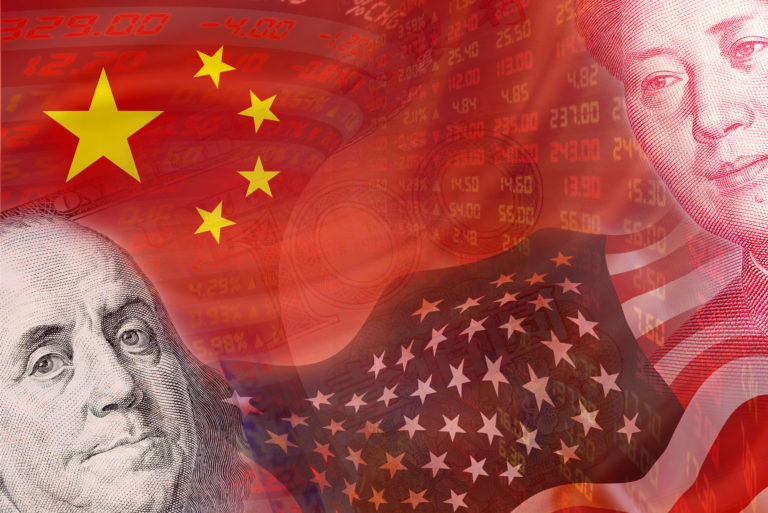Yesterday was a good day for our Dow-to-Gold trade. Gold rose as high as $1,286. And the Dow see-sawed on the minus 400 mark before recovering somewhat late in the day. And you didn’t have to look very hard to see why.
A whole cluster of dark dots appeared in the sky above Manhattan this week.
Dark dots
It’s beginning to look more and more like 2008…or 2000…or 1929. The leveraged loan market of 2019, for example, looks a lot like the mortgage market of 2008, with $1 trillion of debt and securities packaged with tranches of mystery meat and stuck together like a bad sausage.
The Age reports:
‘The epicentre of the last financial crisis was the implosion of junk bonds — the bundles of securitised sub-prime mortgages labelled as collateralised debt obligations, or CDOs.
‘If there were to be another crisis, it wouldn’t be at all surprising if it started with a meltdown of junk bonds again — this time bundles of securitised sub-prime loans labelled as collateralised loan obligations, or CLOs.’
How great is the risk? Colleague Dan Denning is on the case in the latest issue of the The Bonner-Denning Letter :
‘CLOs are the new CDOs: baskets of risky corporate loans that have been bundled together to “disaggregate” the risk. The result is at least a trillion dollars’ worth of ticking time bombs.
‘This time around, CLOs are buried on the balance sheets of pension funds, insurance companies, and banks that have yet to unload them on unwary investors. If our analysis is correct, they’re ready to erupt out of Wall Street’s sewers and onto Main Street America.’
Trade restrictions
Second, Smoot and Hawley are making a comeback. The Wall Street Journal reports on Mr Trump’s upcoming restrictions on ‘foreign’ cars:
‘Mr Trump’s argument, provided by the Commerce Department, is that “the lag in R&D expenditures by American-owned producers is weakening innovation and, accordingly, threatening to impair our national security.” Therefore, “domestic conditions of competition must be improved by reducing imports.”
‘Never mind that Toyota, Honda, Volkswagen, Mercedes-Benz, Mazda, BMW, Subaru, Nissan, Kia and Hyundai all make or assemble cars and parts in the United States. The nearly 500 facilities are located in multiple American states and directly employ 130,000 Americans. Volvo has a plant in South Carolina that may employ 4,000. By the proclamation’s logic, the only car companies that matter to US security are Ford, GM, Tesla and maybe not even Fiat Chrysler, since Italians are significant owners.’
There’s no attempt to understand why research and development (R&D) lagged. No pretence of trying to ‘level the playing field’ or of a negotiating tactic to ‘get a better deal.’ Just pure, dumb protectionism.
A few Americans win. Everybody else pays higher prices for lower-quality autos.
And without the hot breath of rivals breathing down their necks, US automakers can reduce R&D further and doom the entire industry to never again being able to compete in international markets.
Win-lose all the way.
[openx slug=inpost]
Chinese adversaries
Third, the US came down on China’s Huawei — maker of phones and other tech equipment — too. American technology firms will not be able to sell to Huawei without the American feds giving the say-so.
The feds say the Chinese are ‘adversaries.’ They claim they don’t want valuable technology ending up in Chinese hands. They say that the Chinese will spy on us through our online networks.
Naturally, the foreigners are learning not to trust US suppliers…and are looking for essential inputs elsewhere. Win-lose again…with little chance that the US will be a winner.
Unicorns destroying capital
Finally, the hopeless high techs are back, too. Today, they’re called ‘unicorns’ and they’re destroying capital — billions of dollars’ worth — just like dotcoms did in 1999. From Dear Reader John D:
‘Lyft, the jitney taxi-app service…lost $2.281 billion in the last three years.
‘Uber Technologies, Inc…suffered a $655M market loss on its first trading day…with net income from continuing operations: 2016: $3.246 billion, 2017: $4.033 billion, and an unreported (on Yahoo finance) multi-billion loss, as of December 31, 2018. Its EBITDA [earnings before interest, taxes, depreciation, and amortisation] is a mind-numbing -$2.4 billion…
‘Another recent IPO is Pinterest, that IPO’d at $19 a share. Its 2017 operating income was -$137 million and 2018 was -$74 million. It lost $41 million in Q1 2019…
‘Beyond Meat is a purveyor of vegetable-based hamburger, chicken, and sausage. Its operating income for the last three years was: 2016: -$24 million; 2017: -$21 million; and 2018: -$28 million. It was the first veggie-meat company to the IPO market at $25 a share, and reached an astonishing $92.92 on May 15.’
One thing after another…Declining sales…Slowing GDP…Fewer housing starts.
Is our tattered Crash Alert Flag — that we raised a month ago — still flying?
You bet it is.
Regards,
Bill Bonner
